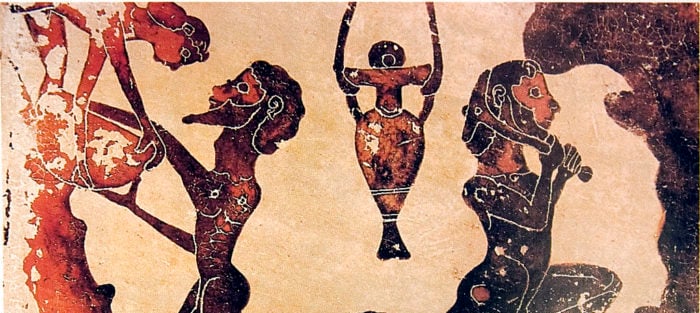
Generally speaking, the institution of slavery was an integral part of ancient Greece and the ancient world. In the strictly structured ancient Greek society, the thousands of slaves formed the base of the social pyramid and were often treated as “talking tools” (instrumenta vocalia), as Marcus Terentius Varro, the Roman polymath characterized them. Aristotle, on the other hand, described them as “living property.”
What was it like to be a slave in Ancient Athens?
Each free citizen had at least one slave at his disposal. Specifically, slaves in Athens included both non-Greeks and Greeks who were either prisoners of war or had lost their freedom due to poor economic conditions. The majority of slaves worked in their owner’s home or workshop.
Slaves had no political rights. Their freedoms were limited to participation in quite specific religious festivals. Of course, some owners afforded their slaves much greater amounts of independence depending of what was deemed feasible. In general, however, slaves had the right to testify as witnesses in the democratic city’s court system.
The quality of life for slaves in Athens and their position in society was, in fact, superior to that of slaves elsewhere—strange as this may sound. It should be mentioned that the greatness of Athens would not have been possible without the contributions of slaves. The role of slaves in the building of the Parthenon, the symbol of Athens, is, nevertheless, a different story.
The construction of the Parthenon of Acropolis
During the mid-5th century BC, Athens was the greatest cultural and military center of its time. It was then that Greek politician Pericles initiated the ambitious building project of the Parthenon. Delian League funds were utilized for this project in a more general effort to maintain balance in the democratic community.
The most important buildings on the Acropolis were erected during this period. The Parthenon was built between 447 and 432 BC, and it was dedicated to the city’s patron deity, Athena Parthenos (Virgin). Some believe the building was completed by 438 BC. That same year, a great gold and ivory statue of goddess Athena, constructed by the great sculptor Phidias for the interior, was erected.

A project the size of the Parthenon attracted specialized quarrymen, carpenters, metalworkers, and stonemasons from various parts of the ancient Greek world. Slaves and metics (foreigners) worked together with Athenian citizens, doing the same jobs for the same pay.
Temple building was a very `specialized craft, and there were not many men in Greece qualified to build temples such as that of the Parthenon. Hence, these men would travel around and work where needed. Unskilled laborers also played key roles in the building of the Parthenon.
Slaves, Public service and forced labor
As previously stated, in addition to slaves who worked in homes, there were also many slaves that worked in mines, fields and workshops. However, these workplaces were of a different nature. In contrast to the Acropolis project, in the mines of Laurion, slaves comprised the largest part of the labor force.
The mines, while actually owned by the state, were also leased to private individuals. The status of “public service” and, accordingly, the much desired “salary,” which were often a part of public constructions in the democratic state, did not apply in this case.
Certain occupations within the political community were specifically for skilled free workers. Jobs focused on metals, clay, and leather as well as building ships in coastal areas required skilled workers. Professions focused on stone and marble also depended on such laborers, and these occupations blossomed as cities began erecting public and religious monuments and adorning them with sculptural representations and statues.
Of course, it should not be forgotten that manual workers, some of whom were slaves and worked alongside their masters, were also involved in the construction of the Acropolis buildings as well as in workshops and public works construction in general.
Such manual labor activities were in one way or another under the control of the state. It is these types of activities for which we have the most extensive and accurate information and data.
Architects generally received only a slightly higher salary than did skilled workers and were often responsible for hiring stonemasons, sculptors, carpenters, and blacksmiths who would work on construction of public works. The lack of wage disparity across the board for various projects showed that architects were not of any greater importance than were laborers. Furthermore, slaves were worthy to society as were citizens and commoners.

Circumstances of the time indicate that work, including military service and other productive labor, was seen more as a “service” rather than an activity for which a unique, fixed salary was of the utmost importance.
Wages did not differ greatly between professions but were rather controlled to some extent. They ranged from the three obols of the judge’s salary to the one and a half drachma of the rector or architect. The obol, an ancient Greek coin was worth one-sixth the value of a drachma.
Thanks to records, it is possible to calculate the respective position of citizens, metics (immigrants), and slaves among the workers who worked on the public construction sites. There were a total of 409 workers at the construction site of Erechtheion. Of these, twenty of the seventy-one contractors were citizens.
Slaves worked alongside their masters and theoretically received the same salary. They likely then handed part of their salary over to masters. Lastly, a portion of these slaves were probably public servants to whom the state provided a food allowance.
Sources used: “L’Homme Grec” by Jean-Pierre Vernant / “The Builders of the Parthenon” Alison Burford
See all the latest news from Greece and the world at Greekreporter.com. Contact our newsroom to report an update or send your story, photos and videos. Follow GR on Google News and subscribe here to our daily email!



